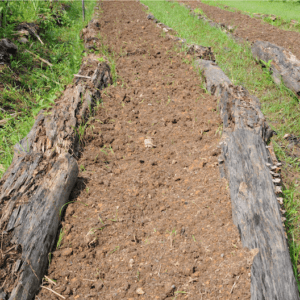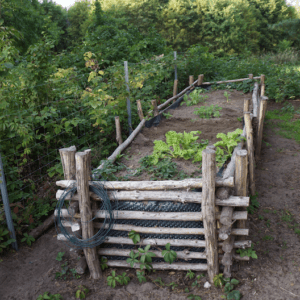If you’ve been following along with our recent posts about raised bed gardening, you likely remember we promised you a great way to use less soil in your raised garden beds with a trick we would reveal in an upcoming post! Well this is it! We’re excited to share this technique that can do a number of really important things in your garden, including saving you money, saving water, increasing your growing space, creating more long-term health for your soil and increasing your production. What is this seemingly too-good-to-be-true technique you ask? Well, when you hear it, you won’t be surprised to know of its German origins.
Hugelkulture
Come again? Yes, Hugelkulture. Now some of you may be very familiar with this permaculture technique, but if you’re not, you’re about to be introduced to a very smart design that mimics nature and helps plants flourish. Hugelkultur is a German word which translates roughly to ‘mound culture”. The basic technique entails building a pile of wood logs and thick branches, then burying them beneath layers of greenery, humus and soil. Just like a forest floor where felled trees are buried overtime by living and dead biomass, eventually becoming a new growing surface for countless new species to take hold and begin the entire process over again of life and death—the natural cycle of all things.
While building a pile is easier, you can also dig out a trench to start your mound, using the removed soil as your top layer once you’ve filled it with plenty of logs, branches, et al.
There are several very important advantages of growing plants on a hugelkulture mound. After all, if you’re going to spend the extra effort to add wood logs and branches, there must be some payoff, right. Here are those awesome benefits of growing with hugelkulture.
Soil Aeration
Soil in a hugelkulture mound is essentially self-tilling. Over time, as the plant matter beneath the soil breaks down, it causes pockets which shift and allow air to flow down into the soil, aerating it and adding to its long-term health. A truly no-dig method of gardening, it creates an environment for beneficial insects, fungi and more!

Slow-Release Nutrients
If built properly with layers of different types of dead and living plant matter, your hugelkulture mound will feed itself over time as the natural composting process takes place, sending vital nutrients back up into the plants it cradles. This means your soil will continue to stay fertile for years to come, as thick, dense pieces of wood are slowly broken down by the flora and fauna present in this flourishing environment.
Soil Warmth
For those living in states where growing time is stretched thin, hugelkulture can have the benefit of providing warmer soil thanks to the decomposition process taking place beneath the garden beds. Just like a steaming compost mound, over time a hugelkulture bed will create warmth which can be very beneficial to newly emerging seeds and sprouts.
Growing Space
If you have a 5’x10’ space to grow, creating a mound of any height will exponentially increase the total surface area available for growing. So, for those who have a very small growing space, hugelkulture is a good option for squeezing out as much production as possible with what little space you have.
Water Retention
Moisture is a critical component of any garden. Too dry—bad. Too wet—bad. Striking a balance is important, and a hugelkulture mound makes that challenge far easier. All that fibrous, dense plant matter both holds moisture and helps with soil drainage. Water can’t pool as gravity pulls it down through the pockets of the biomass, while that biomass sucks moisture in and releases it back into the soil above as it dries.
Raised Beds
In a natural marriage, the concept of hugelkulture has been successfully applied to growing in raised beds because of many of the reasons previously mentioned, and most importantly water retention, nutrients, soil aeration and warmth. One of its greatest assets in a raised bed garden, however, is that it significantly reduces the amount of soil needed—allowing you to build your beds as high as you’d like, without incurring massive soil bills! Just remember, you’ll still need to move all the logs and branches necessary to get started!

Getting Started with Hugelkulture
If you don’t have access to the inputs necessary on your property like logs, branches, etc. you’ll likely be able to find them locally for very cheap if not free. Search Craigslist or Facebook Marketplace for logs, branches, firewood, etc. You’ll be surprised what people give away for free and it will likely be a manageable size to carry and place into your beds or mound!
Like pretzels, bratwurst, and Oktoberfest lager, you can add the awesome German technique of hugelkulture to the list of beloved German contributions to society! Do you have a hugelkulture mound? Tell us about your success or tips in the comments below!